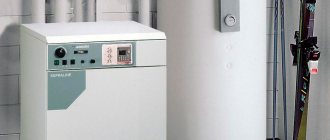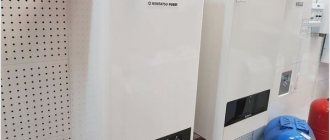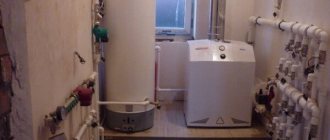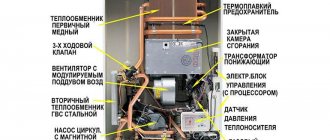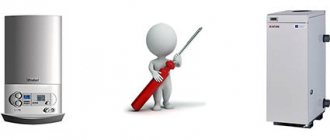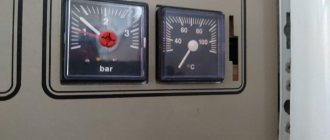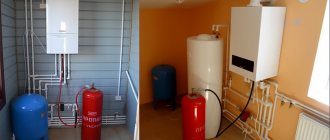The main function of a heat exchanger for a boiler
In the heat exchanger, water is heated, which circulates in the system and transfers heat to the radiators.
Gas and air are supplied to the boiler burner for combustion. The gas burns, releasing heat, and the combustion products are discharged outside. The heat source in this case is a stationary element.
The coolant - water or antifreeze - enters the heat exchanger. This is a device that provides heat exchange between two environments with different temperatures. The latter is located in the combustion chamber above the burner. Water, moving through the heat exchanger, is heated and supplied to the heating pipes. Most often, the device takes the form of a set of plates or tubes. The larger its working surface, the better and faster the water heats up.
Operating principle
Cast iron gas heating boilers are similar in operating principle to conventional units. They contain the same elements: circulation pump, gas burner, heat exchanger, combustion chamber. The operating process of the device is based on burning fuel in a combustion chamber; it transfers thermal energy to a coil with water. The coil, made of cast iron, is the main key element of the boiler; its purpose is to gradually and evenly heat the coolant.
There are many positive aspects in the operation of such units:
- Firstly, they are not susceptible to corrosion.
- Secondly, heat is distributed evenly.
- They withstand thermal loads well.
- With proper care they can last for decades.
As a disadvantage of a gas boiler with a cast iron heat exchanger, it can be noted that such devices are prone to mechanical damage and also weigh a lot. Another drawback is that cast iron is very sensitive to the temperature difference between the supply and return coolant. In the event of a strong drop, cracks appear on the heat exchanger, as a result you will have to resort to repairs, which will be expensive.
Material of manufacture
The heat exchanger for the boiler is made from durable materials that conduct heat well, are not prone to corrosion and are sufficiently resistant to pressure. Since the cost of the material also has to be taken into account, the choice is limited.
Steel
A steel heat exchanger is cheaper in price, but less durable.
This is the most affordable material. Steel is very strong, but can be processed well. The price is low. The advantage of this option is resistance to high temperatures. Steel is plastic and does not crack when heated, and does not deform even in areas in contact with the burner.
A steel heat exchanger for a solid fuel or gas boiler is prone to corrosion. Water inside the tubes and combustion products in the boiler chamber have a destructive effect on the material. This affects durability. The steel model weighs a lot, which leads to additional fuel consumption for heating the element itself.
The stainless steel heat exchanger is resistant to corrosion and lasts for at least 50 years.
Cast iron
The material is much more resistant to corrosion than steel, and is not afraid of rust and the action of acid anhydrides. The service life reaches 50 years. However, cast iron is a brittle alloy and can crack under the influence of temperature. To avoid damage, the cast iron tubular heat exchanger must be washed: if ordinary water is used, then once a year; if antifreeze - then once every 2 years; if distilled liquid - once every 4 years.
The weight of a cast iron element is even greater, so more fuel and time have to be spent on heating.
Copper
Copper is a noble metal that is not susceptible to any type of corrosion. It is chemically inert and tolerates pressure well. Copper conducts heat better, so less fuel is required to heat the element itself and the flowing liquid. The weight of the copper model is small, the dimensions are compact with a very developed working surface.
The disadvantage is the high price. Also, the copper heat exchanger is too sensitive to heating to high temperatures. More often found in boilers from foreign manufacturers.
Copper
Cast iron
Steel and heat exchangers: a wide range of options
2009-04-29
(0) (21672) (1)
Published in SOK magazine No. 3 | 2009
Rubric:
- Heating
The heat exchanger is one of the most important elements of a heating boiler. The purpose of the heat exchanger, as the name implies, is to transfer heat from the combustion gases to the heating circuit coolant (primary heat exchanger) or, in some cases, from the heated heating circuit coolant to the hot water circuit water (secondary heat exchanger). In modern heating boilers, heat exchangers are made of cast iron, steel or copper. In this article we will evaluate the positive and negative qualities, as well as design features of steel heat exchangers.
STEEL
Steel (German: Stahl) is an alloy of iron with carbon and other elements, the carbon content of which ranges from 0.02 to 2.14%.
Steel is one of the main materials for the manufacture of not only heat exchangers, but also many other components of heating equipment. Depending on the purpose, steels are subject to various requirements. There are a large number of steel grades, differing in chemical composition, structure, physical and mechanical properties. Steel smelting Steel
is produced mainly from cast iron and steel scrap in steelmaking units of metallurgical plants as a result of oxidation processes, the purpose of which is to remove most of the impurities of cast iron (carbon, silicon, manganese, sulfur, phosphorus) within the limits of the requirements for a particular grade of steel.
In modern metallurgy, the main methods of steel smelting include the oxygen-converter process (transition of liquid iron into steel without fuel consumption by blowing with air or technically pure oxygen), the open-hearth process (oxidative smelting of iron-containing materials loaded into an open-hearth furnace by injecting a hot mixture of combustible gas and air ) and electric steelmaking process (smelting steel in electric furnaces using the heat of an electric arc between the metal and graphite electrodes). Changing the properties of steel
To change the properties of steel, various types of processing are used: thermal (hardening, annealing), chemical-thermal (cementization, nitriding), thermomechanical (rolling, forging).
When processing steel, to obtain the required structure, the inherent property of allotropy (polymorphism) of iron is used, i.e. the ability to exist in different crystalline forms depending on temperature. The transition from a liquid to a solid state is accompanied by a certain arrangement of atoms in space - the formation of a crystal lattice. The structure of the metal formed during the crystallization process depends on the nature of this process. Allotropic forms of iron (as well as other metals) are designated by Greek letters (α, β, γ, σ), starting with the modification that exists at a lower temperature. When iron is cooled from a liquid state to a temperature of 15–20 °C, it undergoes internal transformations expressed by four critical points. At 1539 °C it crystallizes in the form of a modification of “sigma iron” (σiron) with a body-centered cubic crystal lattice (one atom in the corners of the cube and in its center). At 1392 °C, “sigma iron” (σiron) transforms into the “gamma iron” (γiron) modification, forming a cubic face-centered crystal lattice (one atom in the corners of the cube and in the center of each face). At 911 °C, “gamma iron” (γiron) transforms into “beta iron” (βiron), crystallizing again into a body-centered cubic lattice. At 768 °C (Curie point), non-magnetic “beta iron” (βiron) transforms into magnetic “alpha iron” (αiron) without fundamental changes in the crystal structure. The interaction of carbon with two modifications of iron (α and γ) leads to the formation of solid solutions. Iron modifications have different properties: γ iron dissolves carbon relatively well, forming an interstitial solid solution called austenite. The maximum solubility of carbon in α-iron is 2% at 1130 °C. In α-iron at 723 °C the maximum dissolves 0.02% of carbon. A solid solution of carbon in α iron is called ferrite. Excess carbon that does not dissolve in α iron forms a chemical compound with it - cementite Fe3C. When steel is hardened, a metastable phase is formed - martensite - a supersaturated solid solution of carbon in α-iron. At the same time, steel loses its ductility and acquires high hardness. By combining hardening with subsequent heating (tempering), it is possible to achieve an optimal combination of hardness and ductility. A description of the phases and structures of iron-carbon alloys is given in detail in the sidebar “Phases and structures of iron-carbon alloys.” To ensure the required technological and operational characteristics at various stages of obtaining the final material, steel is also subjected to alloying (from the Latin ligo - I bind, connect), i.e. introduction of additional elements into the melt. Alloying can be used to improve mechanical properties (strength, ductility, toughness), physical properties (electrical conductivity, magnetic characteristics, radiation resistance) and chemical properties (corrosion resistance). Among the main properties imparted to the steels used for the manufacture of heat exchangers, heat resistance and corrosion resistance are of particular importance, incl. in a slightly acidic environment. Classification of steels
According to their purpose, steels are divided into structural (up to 0.8% carbon) and instrumental (from 0.7% carbon).
Steels with special properties are distinguished as a separate class: electrical (can contain up to 0.5% aluminum as an alloying additive), magnetic (contain a high percentage of chromium or cobalt), stainless (with a chromium content of 12–20%), acid-resistant (stainless steel option). steel with the addition of molybdenum and titanium), etc. The content of non-metallic impurities is the basis for the classification of steels by quality: ordinary quality, high-quality, high-quality and especially high-quality. According to the chemical composition, steels are divided into carbon and alloy. Carbon, which gives iron alloys strength and hardness, reducing ductility and toughness, greatly affects the properties of steel even with a slight change in its content. Based on carbon content, high-quality carbon steels are divided into low-carbon (up to 0.25% C), medium-carbon (0.3–0.55% C) and high-carbon (0.6–0.85% C). Alloy steels according to their chemical composition are divided into low-alloy (with a total content of alloying elements up to 2.5%), medium-alloy (2.5–10%) and high-alloy (above 10%). In the manufacture of heat exchangers, high-quality low-carbon structural steels are usually used or stainless steels. Low-carbon quality structural steels with a carbon content of 0.15 to 0.25% are designed for parts that require a hard, wear-resistant surface and a tough core. During the manufacturing process, they are saturated with carbon from the surface (cemented), and the surface layer after cementation is strengthened by quenching in water (heating above the temperature of the polymorphic transformation, followed by rapid cooling) in combination with low-temperature tempering (heating to 250 ° C, followed by slow cooling). This treatment provides high surface hardness and maintains the required toughness and specified strength of the metal core, which is weakly hardened due to low hardenability. These steels are ductile, easy to stamp and weld. They are used, among other things, for parts of boiler and turbine construction (superheater pipes, coils) operating under pressure at temperatures from –40 to +425 ° C. Chromium up to 2% and nickel 1 are used as the main alloying elements in structural steels –4%, manganese up to 2%, silicon 0.6–1.2%. Alloying elements such as molybdenum (0.2–0.4%), tungsten (0.5–1.2%), vanadium (0.1–0.3%), titanium (0.1–0.2 %) are usually introduced into steel in combination with chromium and nickel in order to further improve certain physical and mechanical properties. Stainless steel is a complex alloy steel that is resistant to corrosion in the atmosphere and aggressive environments. The main alloying element of stainless steel is chromium Cr (12–20%), the content of which directly determines the resistance to corrosion: with its content of more than 12%, the alloys are stainless under normal conditions and in mildly aggressive environments, more than 17% are corrosion-resistant in more aggressive environments oxidizing and other environments, in particular in nitric acid with a strength of up to 50%. The reason for the corrosion resistance of stainless steel is explained mainly by the fact that a thin film of insoluble oxides is formed on the surface of a chromium-containing part in contact with an aggressive environment, and the condition is of great importance surface of the material, absence of internal stresses and crystalline defects. In addition to chromium, stainless steel contains elements that accompany iron in its alloys (carbon, silicon, manganese, sulfur, phosphorus), as well as elements introduced into the steel to give it the necessary physical and mechanical properties and corrosion resistance (nickel, again manganese, titanium, cobalt, molybdenum, niobium - see table “Alloying elements of stainless steel”). The approximate chemical composition of various types of stainless steels is given in table. 1. Marking of steels
Various types of steels are marked with numbers and letters indicating their approximate composition.
Different countries have different designation standards. Examples of correspondences between the designations of stainless steels are presented in table. 2. The decoding of the designations of alloy steels according to GOST is as follows. The letters in the marking indicate which alloying element is included in the steel: ❏ G - manganese Mn; ❏ C—silicon Si; ❏ X – chromium Cr; ❏ N – nickel Ni; ❏ D – copper Cu; ❏ A - nitrogen N; ❏ F—vanadium V; ❏ B – niobium Nb; ❏ B—tungsten W; ❏ E—selenium Se; ❏ K—cobalt Co; ❏ L — beryllium Be; ❏ M—molybdenum Mo; ❏ P – boron B; ❏ T—titanium Ti; ❏ Yu - aluminum Al. The number immediately following the letter is the average percentage of the element. If the element contains less than 1%, then numbers are not placed after the letter. The first two-digit number indicates the average carbon content in hundredths of a percent. The letter A in the middle of the steel grade shows the nitrogen content, and at the end - high-quality steel. In some cases, before the grade of alloy steels, letters indicate their areas of application. Thus, automatic steel grades begin with the letter A, bearing steel grades with the letter Ш, high-speed steel grades with the letter P, electrical steel grades with the letter E, and magnetically hard steel grades with the letter E. At the end of the grade of structural steel there may also be additional letter designations: for example, the letter K denotes a variant of the chemical composition of steel with increased corrosion resistance in the atmosphere and is intended for the manufacture of boilers and vessels operating under pressure and at temperatures up to 450 ° C (boiler steel). Let us consider, for example, one of the most common grades of stainless steel used for the manufacture of heat exchangers, EN 1.4404. According to GOST, this is 03Х17Н13М2: the first number indicates the carbon content (FEATURES OF STEEL HEAT EXCHANGERS The steels used in the manufacture of heat exchangers have good weldability. The use of welded structures makes it possible to make fireboxes of optimal design in terms of heat exchange and gas movement. Stainless steel has an unpleasant feature in this regard : after processing by conventional welding methods, it practically loses its stainless properties in the places of welded seams. A porous oxide layer is formed on the surface of the welded joint, containing mainly chromium released from the base material, as a result of which a layer with a reduced chromium content is formed under the oxide layer. In order to In order for the corrosion resistance of a welded joint to be as high as that of the base material, the welded joint must undergo subsequent thermal and/or mechanical treatment to remove the oxide layer and the zone with reduced chromium content. This further increases the cost of stainless steel products (not counting the fact that stainless steel itself is an order of magnitude more expensive than ordinary steel). However, products made from ordinary steel are not resistant to corrosion, and for this purpose, the steel surfaces of heat exchangers are protected with various anti-corrosion coatings. Especially severe damage to a steel heat exchanger can be caused by the so-called “low-temperature corrosion”, which occurs due to the condensation of combustion products on its walls. The condensation mechanism is as follows: flue gases have a “dew point” - a temperature at which, when cooled, the water vapor they contain becomes saturated and turns into a liquid state. Depending on the type and composition of the fuel, the temperature at which condensation begins may differ: for methane it is about 60 °C, for diesel it is about 50 °C. At the same time, it is not so much the water itself that is scary, but the acids dissolved in it: carbonic, sulfuric, sulfurous and some others. Condensation on the surface of the heat exchanger is possible at the initial moments of periodic startup of the boiler and when coolant with a temperature below the “dew point” enters the boiler from the return pipe of the heating system or from the make-up coolant. An additional advantage of steel heat exchangers in the fight against corrosion is the smooth surface and round cross-section of the smoke channel , on the walls of which condensate drains without causing significant damage. To achieve these goals, manufacturers try to reduce the area of welded seams as much as possible, using, for example, seamless structures made of seamless pipes. But if you don’t take things to the “dew point” (this, of course, does not apply to condensing technology), steel heat exchangers acquire tangible advantages over cast iron ones due to their plasticity, thanks to which they can easily withstand sudden temperature changes in the supply and return lines. This same quality (ductility) helps them not crack from an accidental impact, which is why boilers with steel heat exchangers are most often supplied fully welded or, at least, as assembled as possible. Steel boilers have half or even three times less weight compared to cast iron ones, and therefore have an advantage when designing high-power floor heating equipment. In addition, a steel boiler uses significantly less raw material than a cast iron one. The wall thickness is usually 2.5–4 mm. In wall-mounted thermoblocks, steel generally represents iron-containing alloys in splendid isolation, competing with copper. Thin steel walls also have disadvantages: steel boilers are more quickly corroded and burn out. Therefore, the service life of steel boilers is the shortest among heating equipment. Manufacturers give them from 10 to 25 years. According to European standards, there is nothing wrong with such a short service life: after this period of time, the boiler is considered obsolete, and there is no point in producing more reliable (and expensive) equipment if it will still be replaced after 10 years. Boilers with steel heat exchangers have less heat storage capacity and less thermal inertia than cast iron thermoblocks. This is convenient if you need to ensure a quick response when operating conditions change (simultaneous heating of large volumes of coolant, a large number of circuits with variable flow). However, the thermal inertia of a particular boiler largely depends on the volume of the water jacket (the amount of water in the heat exchanger). It is believed that a boiler with a heat exchanger of small volume and weight is safer - if the jacket is damaged, the power of a possible explosion is less, and the heating system, as already mentioned, reacts faster to automation commands. In addition, in small-capacity heat exchangers, the coolant moves faster when heated, which prevents the formation of scale on the walls - but there is a danger of the coolant boiling. A large-capacity heat exchanger increases the thermal inertia of the boiler and, accordingly, its cooling time. This is especially important for solid fuel boilers, where automatic fuel loading cannot be organized (the larger the heat exchanger volume, the longer the time between loadings). But such a boiler responds extremely slowly to automation commands. Steel is extremely popular among heating equipment manufacturers. Steel heat exchangers are equipped with both wall-mounted and floor-mounted hot water boilers, steam boilers, cylinder water heaters, heating points, economizers, swimming pools, etc. Depending on operating conditions, the likelihood of corrosion and economic considerations, manufacturers make a choice between different types of structural and stainless steel. The type of fuel on which the boiler will operate is of great importance. Often the design includes several types of steel, several types of iron alloys (for example, biferral heat exchanger*), a combination of steel with other metals (bithermic heat exchanger: steel + copper). TYPES OF STEEL HEAT EXCHANGERS
Floor-standing boilers
Direct-flow design
The simplest design of a primary heat exchanger made of steel was used (and is successfully used) in non-volatile floor-standing boilers of domestic and foreign production, intended for heating systems with natural coolant circulation.
And also in capacitive gas water heaters for the preparation of sanitary water. Heating of water in the heating circuit is carried out according to the principle of a samovar. In the center of a steel container filled with water, called a “water (or boiler) shirt”, there is a steel frying pipe equipped with a turbulant spiral, along which hot chimneys move. Turbulators twist the products of combustion, providing more uniform and effective heat transfer. The burner in the simplest structures of such boilers is under the container and is located on the same axis with a heat pipe. With the development of engineering, manufacturers began to find more successful solutions to increase the efficiency of boilers. For example, to place the axis of the burner perpendicular to the axis of the boiler shirt, and there are several vertical channels with turbules. The ability to change the amount and location of the mounted turbulating spirals made it possible to adjust the temperature of the smoke gases at the output in order to increase the efficiency of heat exchange and prevent condensate formation. Thanks to this, it was also possible to significantly reduce the influence of the shape and size of the chimney in the building on the quality of the boiler. The placement of the combustion chamber directly in the cylinder with the coolant made it possible to stabilize the cycle of the burner and not to worry about the difference in the temperature of the coolant in the supply and reverse highways. A similar structure is used in direct -flow steam boilers, where the complete evaporation of water occurs during a single (direct -flow) passage of water through the evaporative surface of the heating. In the output part of the coils, where moisture remains evaporated and steam overheating (the so -called transition zone) begins with insufficiently clean nutrient water, an intensive formation of scale is underway. For steel itself, this is not scary, but the efficiency of the boiler is significantly reduced. Therefore, more stringent requirements are presented to the quality of nutrient water for steam boilers than to coolant for hot water boilers. Direct steam boilers have an advantage over the system described below with multiple circulation, because allowed to receive pairs of supercritical pressures (more than 22.1 MPa). The multi-way structure
was an important stage in the development of hot water boilers by the development of a multi-route system of horizontal-inventical movement of smoke gases and the horizontal placement of a “water shirt”.
As a result, it became possible to make steel boilers of huge capacities. The multi -way (most often three -way) system provides a reverse movement of flue gases through the channels to ensure more complete and effective heat transfer. The first horizontal course is the movement of hot combustion products directly from the burner to the back of the boiler by a cylindrical combustion chamber surrounded by a wide “water shirt”. Here, the primary heating of the coolant that came from the system of cooled. The second stroke of flue gases is carried out in a narrower pipe in a reverse direction, i.e. From the back wall to the front. During this period, the heating of the coolant in the boiler unit continues. Sometimes the tubes of the second move do several. The third horizontal move is many small tubes in which heat remaining in smoke gases is transmitted to boiler water. At this stage, the task of manufacturers is, on the one hand, in the maximum improvement of heat transfer, and on the other, in the prevention of chimney cooling below the “dew point” (after all, as we recall, steel products are extremely sensitive to low -temperature corrosion). To do this, you have to go to different tricks, for example, the use of profiled convective surfaces. An important role in steel floor boilers is played by the balance between effective heat transfer and the resistance of furnace gases in heat pipes and the hydraulic resistance of the coolant in the boiler, since the rise of heated water should be carried out naturally. Of great importance is the ratio of the power of the burner and the volume of a “water shirt”, which accumulates the energy of combustion and affects the burner operation cycle. Boilers for several types of fuel
steel are very successfully used when creating universal boilers for a replaceable burner and multi -fuel boilers, from which stable work is required in a wide variety of temperature conditions.
In table 3 shows the temperatures of the flame of the main energy. Wall boilers
steel occupies a leading position among materials used for the manufacture of wall boilers.
Both primary and secondary heat exchangers are made from it. The primary heat exchanger is usually a pipe curved in the form of a coil in one plane, on which the nutty is fifty or attacked. Secondary heat exchangers (or heat exchangers) transmit heat from the heating heating of the heating circuit to the sanitary water of the hot water supply circuit and are the soldered stainless steel plates with each other. Due to their high thermal conductivity and a large area of the plates, the necessary heat transfer is provided. The direction of the flows of the coolant and cold water, as a rule, are directed towards each other. Due to the flow rate of the coolant, the secondary heat exchanger is less at the risk of deposition of hardness salts on the internal surfaces. There are also designs of the type “two in one”, called the Betermic. Such heat exchangers combine the heating elements of two contours in one structure: heating and hot water supply. Organizationally, they are a coaxial pipe, on the outer surface of which the plates are attacked. The internal (usually copper) pipe is intended for the water water circuit, and the outer (steel) for the coolant of the heating system. The use of a bittermic heat exchanger in the boiler eliminates the need for a three -way valve, which reduces the cost of the boiler and increases the reliability of its work. The disadvantage is limited heat transfer in the mode of operation of hot water supply, so the amount of heated sanitary water is less than in boilers with two heat exchangers. In addition, it is not recommended to use boilers with boutermic heat exchangers with water of high rigidity, since due to a large temperature difference in heating contours and hydraulic devices, the salts decay process is more intensively. Water heaters
of secondary heat exchangers can exist outside the boiler, in capacitive water heater water heater.
In most cases, tubular heat exchangers made of copper or stainless steel located inside the water heater tank are used. The heat of boiler water is transmitted to sanitary water through the walls of the coil. There are also constructions called "tank in the tank." This is a heat exchanger of two containers located one in another. The internal container contains a heated fluid (secondary circuit), and the outer container contains a warming liquid (primary circuit). The internal container is made of stainless steel and has wave -like walls of the cylindrical part, designed to increase heat transfer. Water heaters with a double wall are mainly used by manufacturers in order to get rid of the deficiencies inherent in boilers of the first type: the heat exchange surface of such a device is 2.0–2.5 times higher than the surface of the snake and the speed of the formation of the scale is much lower. The economizers
of the economizer is a heat -generated device for the selection of the residual heat of the smoke gases to increase the boiler efficiency (up to 12 % with respect to the lower heat of combustion) and fuel savings.
The energy extracted in this way is used for the initial heating of the coolant in the reverse line. This device currently finds more and more use. Economizers are used in steam and hot water boilers and are remote and built -in. Remote economizers are used to modernize ordinary heating plants, where it is required to avoid condensation inside the boiler unit itself, but I really want to squeeze everything possible from the energy carrier. The built -in economizer is used in steam boilers and in condensation water heaters. Since the formation of condensate in the economizers is not just a common thing, but a sign of its effective work, matte or polished (mirror) stainless steel is often used for their manufacture about 0.8–1.0 mm thick. The specific composition of the steel is selected taking into account the energy carrier used in the boiler, since the acid component of the smoke gases is directly related to the type of fuel burned. It is important that the walls of the economizer are as smooth as possible so that the condensate unhindered flows through them into a condensate venture. Heating points
heat exchangers can be not only built into various containers, but also apply as independent devices.
In cities for heating systems of multi -storey buildings and enterprises, heat points are often used. The task of the heat point includes the transfer of heat from a centralized boiler room to a separate heating circuit. Currently, the so -called high -speed heat exchangers of two types are used. The fragrant heat exchanger
heat exchangers of this type are designed for heat transfer between different media: liquids, liquids and steam, liquids and gases and are used in cases when a large heat exchange surface is required - the heat transfer surface can be from several hundred centimeters to several thousand square meters.
The fragmentation heat exchanger is the sections cooked together, each of which consists of a steel cylinder of a large diameter (casing), inside which several pipes of small diameter (pipe) are placed. The coolant from the boiler room is passed through the pipes, and water from the heating contour - a gasket in the interpretation space of the casing. Pipe beams are fastened with pipe grilles and limited to casings and lids with nozzles. The tubes are made by straight or curved (U-shaped) diameter of 12–57 mm. The material of the tubes is selected depending on the medium washing its surface. Drums of steel, brass and special alloys are used. The thickness of the wall of the casing is determined by the maximum pressure of the working environment and the diameter of the device (but not thinner than 4 mm). Pipe and interpretation spaces in the apparatus are disconnected, while each of them can be divided by partitions into several moves. Partitions are designed to increase the speed and heat transfer heat transfer coefficient (intensification). The plate heat exchanger
surface of the heat transfer in these heat exchangers is formed from parallelly located thin stamped plates with a profiled surface and holes for coolants in the corners. The most common in modern heat exchangers are the plates of tape-flow and mesh-flow types. Such plates have increased rigidity compared to flat plates. Due to the presence of corrugations on the surface of heat exchange, winding sloppy inter -plastic channels are created, in which a significant turbulization of moving working media at a relatively low flow rate is achieved. The number of plates depends on the consumption of liquids, their physical characteristics, hydraulic resistance and a given temperature regime. Standard plate thickness 0.5-0.8 mm. The working environment in the heat exchanger moves the gasket through the holes provided for them between the neighboring plates through the slotting channels of a complex shape. The channels for heating and heated coolants alternate with each other. When passing the workers of the medium through the heat exchanger, the heating medium gives part of the heat to the plate, which, in turn, is cooled on the other hand, the heated medium. The seal located around the perimeter of the plate covers two angular holes through which the flow of the working environment enters the inter -plastic channel and leaves it, and after two holes isolated by additionally ring seals, the oncoming stream passes in transit. The corrugated surface of the plates enhances the turbilization of the flows of working media, the rigidity of the heat exchanger structure and increases the heat transfer coefficient. Between the plates there are rubber seals that provide reliable insulation and divide the direction of the media through the channels of the heat exchanger. The plate heat exchangers are produced in whole or collapsible. For different parts of the plate heat exchangers, various materials are used: for example, the plates are usually made of stainless steel, and the casing can be made of ordinary structural steel. A plate heat exchanger is considered a more advanced structure compared to the cirving pipe. Its advantages include: rapid temperature regulation due to the small volume of water in the heat exchanger, the possibility of flexible selection and change in power if necessary, the ease of cleaning and detecting leaks, the inability to mix the coolants during depressurization of the contours (this is especially important when using a heat exchanger for heating of sanitary water in a hot system water supply). ❏ 1. Big Soviet Encyclopedia in 30 tons, ed. III. Publishing House "Soviet Encyclopedia", 1969–1978. 2. Fundamentals of industrial technology (dictionary-reference book). Educational Manual / L.A. Krasov, Krasnoyarsk State UNT, Krasnoyarsk, 2003. 3. Metals and alloys (reference book) / Ed. Yu.P. Solntsev, NGO "Professional", NGO "Peace and Family", St. Petersburg, 2003. 4. Chemical portal Chemport.ru. 5. Free encyclopedia wikipedia.org. 6. Portal "Production of metals" Metallize.ru. 7. The portal of Viktor Mityushov cncexpert.ru. 8. Portal "Samara welding" svarimvse.ru. 9. The site u-stal.ru. 10. Site ctcbentone.ru.
(0) (21672) (1)
Send to a friend
tweet
Classification of heat exchangers
Primary heat exchanger for the heating circuit in the form of a coil with plates
Gas boilers can perform several functions. The main thing is heating the home. However, dual-circuit models also heat water for various household needs: from washing dishes to the bathroom. It is on this basis that heat exchangers are distinguished.
Primary
Serves the heating system. It is a pipe with a fairly large diameter, bent in the form of a coil in one plane. To increase the working surface of the device, plates of different sizes are placed here.
The primary heat exchanger is subject to the highest loads. From the outside it is affected by combustion products - soot, dirt, acid anhydrides, from the inside - by salts dissolved in the coolant. To reduce wear, the part is coated with paint and treated with anti-corrosion compounds.
The best option is a heat exchanger made of stainless steel or copper, since it is not subject to rust and is not afraid of salt deposits.
Secondary
Secondary heat exchanger for hot water supply
This heat exchanger heats the liquid for hot water supply. Its heating temperature is lower, but it is not worth heating water for domestic needs above +60 C. Most often, this is a plate design: it is assembled from many plates with extruded passages through which tap water circulates. Multi-pass models are more effective, since within one plate the liquid changes direction several times, that is, it stays in it longer and warms up better. It is made from steel, copper, aluminum.
Bithermal
When clogged, bithermal heat exchangers must be replaced with new ones.
They consist of 2 pipes inserted into each other. The coolant moves through the inner one, and water for hot water flows through the outer one. The heating fluid is heated in the combustion chamber and partially transfers heat to water for domestic needs.
The design is much cheaper. But although the water here heats up faster, its volume is limited. In addition, the bithermic heat exchanger is very sensitive to water quality and gets dirty much faster. Cleaning the device is not enough. To prevent rapid clogging and failure, it is necessary to install water filters at the inlet.
It is not possible to clean a combined heat exchanger like a regular separate one. If there are large salt deposits or clogging, the element will have to be replaced.
What are the types of heat exchangers for gas boilers?
The heat exchanger in a gas boiler is responsible for receiving heat in order to subsequently transfer it to water. If we are talking about a double-circuit boiler and its operating principle, then there is a primary and secondary heat exchanger. The first is placed above the burner and is represented by a tube with ribs, a curved snake. Water heated to the required temperature in the heat exchanger moves into the three-way valve, after which it enters the heating system. The secondary heat exchanger is represented by a whole system of wave-curved plates, all of them are combined in a single block, on which there are also 4 holes. Water flows through 2 of them, another 2 are responsible for moving the coolant, which is supplied to the heating circuit.
A system of two heat exchangers is called dual. There are heating devices on the market that use a bithermic heat exchanger. It is characterized by a complicated configuration. Copper is used for its manufacture, the element itself is represented by tubes located inside each other: the coolant moves along the outer one, the inner one serves to move water, with the help of which the supply of hot water is ensured.
Gas boilers equipped with such heat exchangers are difficult to operate, the latter being difficult to descale. However, such heating devices are in demand, as they are small in size and heat water very quickly.
Criterias of choice
The main parameter of a heat exchanger is its power.
When choosing a device, the purpose is taken into account - in this case it is heating the coolant, and the type of medium - steam, water, antifreeze. A gas boiler usually works with water, but there are exceptions.
Other selection criteria:
- Coolant temperature at the inlet and outlet - it is necessary to calculate how much heat the consumer should receive. Based on these data, the heat exchanger power is calculated.
- Allowable pressure losses - the water pressure decreases as it passes through the heat exchanger. If it falls too low, it will not be possible to create a column of hot water of sufficient height.
- The maximum operating temperature on the burner reaches 600–700 C. A cast iron and steel heat exchanger can withstand this temperature; copper heat exchangers can withstand this temperature with some difficulty. The aluminum model must not be used.
- Maximum operating pressure – does not limit the choice of design or material.
Dimensions are a significant parameter. With the same efficiency, a shell-and-tube heat exchanger occupies an area 3–4 times larger than a plate heat exchanger.
Correct operation
The heat exchanger is washed depending on the water hardness.
Transportation, installation and operation of the heat exchanger device are described in detail in the instructions:
- The heat exchanger is placed in the apparatus so that it has easy access for inspection and repair.
- Start-up is performed at stable pressure and temperature. Do not increase the temperature faster than 10 degrees per minute or increase the pressure more than 10 bar per hour.
- When filled with water, the air valves and valves behind the heat exchanger remain open. After the pump starts, they are closed. In this way, stable pressure is achieved.
- You need to change the heating parameters smoothly. The slower this happens, the longer the seals and the heat exchanger itself will last.
- The device needs to be cleaned periodically. The plate is cleaned directly in the frame, then the plates are removed and washed. Another method is possible: first removing and then cleaning the plates. It is not recommended to clean shell-and-tube machines. In case of complex blockages, the technician installs a plug.
- Before restarting, check the condition of all gaskets. Pressure and temperature are set as at 1st start.
To avoid salt deposits, a filter is placed on the water pipe in front of the boiler entrance.
Possible faults
Steel products are subject to corrosion and must be replaced.
Most problems require the intervention of specialists. Some can be eliminated by the user:
- Reduced pressure - if caused by contamination, it is enough to clean the heat exchanger. If the connection to the network is incorrect, you need to check the connection with the drawing in the instructions.
- Reduced efficiency - in case of mechanical contamination, the device is washed. If the reason is the accumulation of oil or substandard gases, additional devices are installed to remove them.
- Leakage - most often caused by decomposition of seals. They are being replaced.
- Mixing of working media - occurs when plates or tubes corrode. The plates can be partially replaced, but a new shell-and-tube heat exchanger will have to be installed.
While the warranty is valid, it is prohibited to open the heat exchanger yourself and carry out any repairs.
Popular manufacturers
Cast iron heat exchanger for Beleto floor-standing boiler
Heat exchangers are produced by many manufacturers. The most popular companies in 2021 were the following.
Navien
The largest Korean manufacturer. It produces products intended for household boilers. The advantage is resistance to low water quality and water hammer. The device is perfectly adapted to poor operating conditions.
Baxi
Italian manufacturer. Presents on the market wall-mounted and floor-mounted condensing boilers with a cast iron heat exchanger, as well as electric heaters.
The company makes primary heat exchangers from copper and brass. For secondary plates, stainless steel is used. This increases the cost of the products, but ensures maximum durability.
And others
There are other worthy manufacturers on the market:
- Fondital Victoria Compact is an Italian company. Offers high performance bithermic copper heat exchangers.
- Beleto is a well-known Russian plant that produces a variety of gas equipment. Manufactures steel, cast iron and copper heat exchangers of various types.
- Ariston - offers aluminum and copper heat exchangers. The materials are insensitive to corrosion, and the manufacturing technology guarantees their strength.
If there is a need to increase the efficiency of the boiler when replacing the device, consult a specialist to calculate the required parameters.
Advantages and disadvantages of cast iron heat exchangers
Cast iron is a multi-component alloy based on iron and carbon. Primary heat exchangers in floor-standing boilers are made from it. Cast iron boilers are usually single-circuit. Gray cast iron is usually used for the manufacture of heat exchangers. It got its name due to the color of the fracture. The fact is that in molten cast iron, carbon is in a dissolved state and is evenly distributed throughout the entire mass of the melt, and then, when the molten cast iron is slowly cooled, part of the carbon is released in the form of graphite plates, which gives the castings a gray color. Note that the larger the graphite inclusions, the lower the strength of cast iron. The carbon content in gray cast iron used for the manufacture of heat exchangers is 3.2–3.5%. The presence of graphite makes cast iron quite brittle. Severe mechanical (as a result of careless handling of the boiler) and thermal shocks (sharp temperature changes that occur, for example, when cold water enters an uncooled heat exchanger during make-up) can lead to the formation of cracks and subsequent depressurization of the heat exchanger. For the same reason, large temperature differences between the flow and return lines should be avoided. To maintain the required water temperature at the inlet of a cast iron boiler, a bypass line should be provided between the supply and return lines with a three- or four-way mixer or pump. Some manufacturers supply boilers with a system already built into the boiler for pre-mixing the cold coolant from the return line with the heated one. With frequent replenishment of water with high hardness, scale forms inside the boiler, which leads to local overheating of the heat exchanger sections and, again, to the appearance of microcracks. The presence of graphite inclusions in cast iron, however, also has positive aspects. Thus, thanks to microvoids filled with graphite, cast iron dampens vibrations well and has increased cyclic toughness (crack resistance under cyclic loads). Parts cast from cast iron are insensitive to external stress concentrators (grooves, holes, transitions in sections), so the shape of the heat exchanger can be more ridged, and this increases the heat exchange surface. In addition to carbon, gray cast iron always contains other elements. The most important of them are silicon (1.9–2.5%), manganese (0.5–0.8%), phosphorus (0.1–0.3%), sulfur (<0.12%). Impurities affect the quality of cast iron. Thus, silicon, promoting the release of carbon in the form of graphite (graphitization), improves the casting properties of cast iron and reduces its hardness. Manganese prevents graphitization and thereby increases the strength of cast iron, promotes chilling (formation of cementite), part of the manganese combines with sulfur. At the same time, if the manganese content exceeds 1.2%, the shrinkage of cast iron increases and its brittleness increases. Phosphorus increases the fluidity of cast iron and increases its fragility. For high-strength castings subject to impact, the phosphorus content should not exceed 0.15%. Sulfur inhibits the release of graphite, increases shrinkage and brittleness of cast iron, and also reduces the resistance of cast iron to corrosion. The raw materials for casting are iron ore and scrap iron (recycled casting). The purity and quality of cast iron are largely determined by the scrap content. Casting is done in molds made of sintered synthetic sand. In an effort to find the optimal balance between strength and ductility, each manufacturer develops its own unique alloy composition, based on the achievements of the metallurgical industry, the results of its own tests, as well as the financial capabilities of the plant and potential buyers. The ultimate goal is, of course, to improve the performance characteristics and increase the service life of manufactured products. One of the most common gray cast irons is GG20, its Russian analogue is SCh-20 according to GOST 1412–85 (the number “20” in the marking of cast iron indicates the value of the minimum tensile strength, measured in MPa ×10–1). Modern grades of gray cast iron have increased ductility, greater uniformity of structure, as well as high resistance to corrosion and temperature changes, which significantly increases their service life. Heat exchangers made from them can last 30–50 years. One of the important features of cast iron is its ability to form eutectic (from the Greek “e-utektos” - easily melting). The meaning of this phenomenon is that at a certain level of carbon (and other impurities) content in the alloy, the melting point of cast iron decreases and becomes less than the melting point of iron and carbon, both individually and their combination in any proportion. This quality of cast iron ensures its uniformity during the transition from a liquid to a solid state after casting. For reference: the melting point of cast iron is approximately 1200 °C, iron - 1539 °C, carbon - 3500 °C. This means that manufacturers who claim to have developed a special eutectic cast iron are lying a little. Any gray cast iron is by definition a eutectic system. As for the concept of “eutectic cast iron” itself, in accordance with scientific terminology, gray cast iron, depending on the carbon content, is called hypoeutectic (2.14–4.3% carbon), eutectic (4.3%) or hypereutectic (4.3%). -6.67%). The difference between pre- and hypereutectic alloys and pure eutectic alloys is that at the beginning of eutectic crystallization, in addition to the eutectic liquid, there are also primary crystals. Since the cast iron used for the manufacture of heat exchangers contains, as mentioned earlier, from 3.2 to 3.5% carbon, it would be more correct to call it “hypoeutectic”. Manufacturers simply want to emphasize that they managed to select a very good alloy composition that crystallizes at a lower temperature than most other manufacturers and has a good homogeneous structure. Since we are talking about terms, I would like to dwell on such a concept as “high-strength cast iron”. Calling gray cast iron “high-strength” is incorrect, since high-strength cast iron is a separate type of cast iron with spherical graphite inclusions. Gray cast iron, as we remember, contains flake graphite. Note that there is also a third type of cast iron - white, containing flake graphite and used for forging. In the manufacture of heat exchangers, welded structures made of cast iron are almost never used. Welding heating and subsequent cooling change the structure and properties of cast iron in the melting zone and heat-affected zone so much that it is very difficult to obtain defect-free welded joints with the required level of properties. Therefore, cast iron is a material with poor technological weldability. At the same time, gray cast iron is characterized by high casting properties (low crystallization temperature, fluidity in the liquid state, low shrinkage), therefore heat exchangers from this material are manufactured by casting. As a rule, they are cast not entirely, but in separate hollow ring-shaped sections of equal thickness, which are then bolted together or strung on a long rod. Tightness is ensured by a seal, which can be used as a special cord, silicone mastic, etc. The internal cavities of the sections are profiled, thereby providing a large heat exchange area with small dimensions, reducing the rate of passage of combustion products (due to turbulization) and eliminating stresses that can arise due to a significant temperature difference between different sections of the structure. Round, rectangular or square protrusions are cast on the outer surface of the section in contact with the flue gases. Arranged in a checkerboard pattern, they form a chimney channel of complex shape. An increase in the heat exchange area and the creation of turbulence in the movement of flue gases contributes to an increase in heat transfer. Modern cast iron heat exchangers are made multi-pass (usually with three, less often with two or four passages of flue gases), which makes it possible to achieve high efficiency and reduce emissions of harmful substances into the atmosphere. When assembled together, the sections form a combustion chamber and several channels for flue gases. Sometimes additional stainless steel turbulators are placed in these channels. By designing sections, boiler manufacturers have the opportunity to implement quite complex patterns of flue gas movement, including those in which gases pass simultaneously through two or more parallel channels. There are models of cast iron boilers that are equipped with two separate boiler blocks located in one building. Moreover, each unit is equipped with a separate burner and a separate heat exchanger, and they have common supply and return lines. The result is, in fact, a cascade of two boilers. Thermal insulation of the heat exchanger plays an important role, aimed at ensuring that as much heat as possible is transferred to the coolant and as little as possible to the air in the boiler room. The sectional design is optimal in terms of the characteristics of cast iron. Its main advantages are as follows: it is much easier to move individual sections of the boiler inside the building than the assembled boiler, which is important considering the significant weight of cast iron heat exchangers; the sectional boiler can be transported, as well as carried through narrow doorways and up stairs in disassembled form, and assembled directly at the installation site; there is no need to replace the casting mold and reconfigure the line at the plant when producing heat exchangers of different capacities - after all, the required power is achieved by adding sections; in case of depressurization or deformation, there is no need to replace the entire heat exchanger - it is enough to replace the defective sections; cleaning a sectional heat exchanger is faster, easier and more efficient, which is of great importance, since it must be carried out regularly - because due to contamination of the surface of the heat exchanger with soot and soot, as well as deposits of hardness salts and dirt on the inner surface of the coil, the thermal conductivity of the walls of the heat exchanger is significantly reduced and becomes difficult circulation of the coolant, and therefore heat exchange is reduced (for this reason, when putting the boiler into operation, a prerequisite is the presence of a filter in the heating and hot water system); Due to the mobility of the sections relative to each other, the prefabricated cast iron structure makes it possible to slightly compensate for the lack of elasticity; at the same time, the graphite contained in the cast iron provides a high coefficient of absorption of vibrations during vibrations of parts and additional lubrication of friction surfaces. One of the positive qualities of cast iron is its high corrosion resistance, due to an interesting property: during operation, the surface of a cast iron firebox becomes covered with so-called dry rust, due to which corrosion practically stops in the future. This feature makes cast iron heat exchangers resistant to the effects of burner flames and aggressive condensate formed during the initial moments of periodic startup of the boiler. The corrosion rate of cast iron in water and acids (and condensate is a solution of carbonic and sulfuric acids) is 1.5–2 times less than that of steel. For example, daily corrosion of cast iron in a 10% sulfuric acid solution is 702 g/m2, in distilled water - 5.51 g/m2 (for steel these figures are 1474 and 6.15 g/m2, respectively). All this allows cast-iron boilers to be used even in low-temperature conditions (return temperature below 55 °C), when condensate forms regularly. To increase the reliability of their boilers, some manufacturers use two-layer structures (cast iron + steel) that prevent the formation of condensation. Boilers with a cast iron heat exchanger have good heat storage capacity and high thermal inertia, due to which less fuel is required to maintain a sufficient level of heat. It would seem that this is undoubtedly a positive quality. However, high thermal inertia also has a downside. Indeed, if it gets warmer outside and the automation reacts to this by changing the burner operating mode, then the heat exchanger, due to its mass, will remain hot for a long time (2-3 hours), continuing to heat the coolant and the room. Therefore, for a boiler with a cast iron heat exchanger, you should choose automation that can respond to temperature changes in advance (turn on the boiler in advance, turn off the pumps after a certain time after turning off the burner, etc.). Gray cast iron is used for the manufacture of floor-standing boilers of the average price category with a capacity of up to several megawatts . High-power boilers are usually still made of steel: due to their significant weight, a cast-iron boiler is difficult to transport, and in addition, it requires a reinforced floor or foundation. For the same reason, cast iron is not used for the manufacture of wall-mounted cast iron boilers: they are too heavy for installation on the wall. When designing a boiler room, it is necessary to take into account the weight of the boiler so that the floor in the boiler room can withstand the load.
